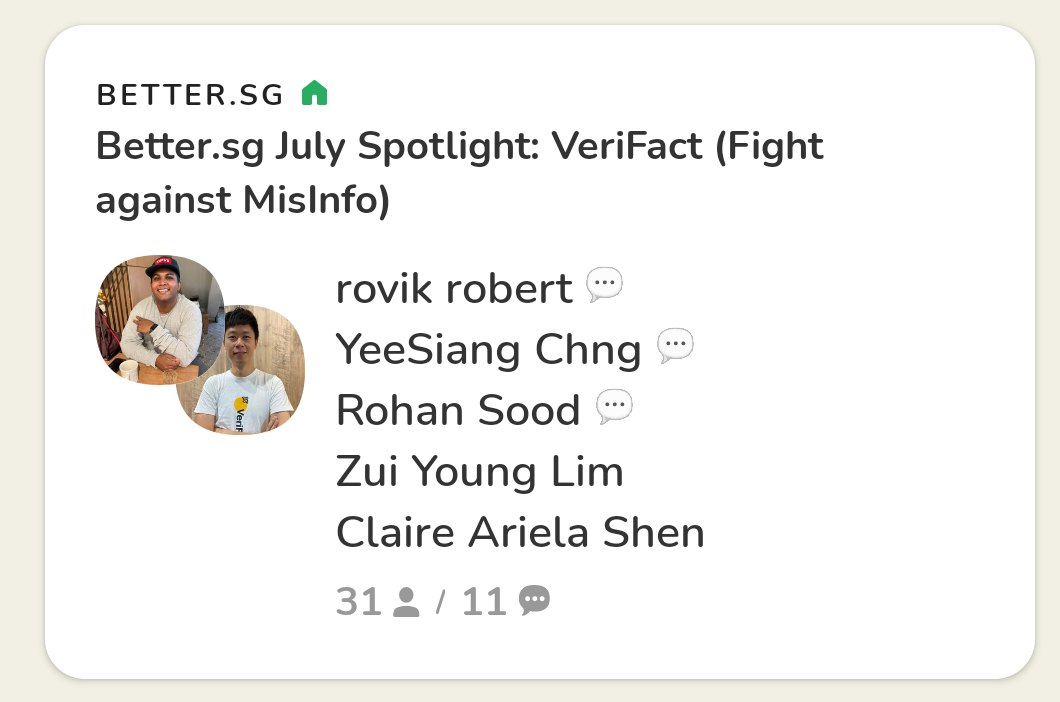Caveat Lector (pronounced ca-ve-at | lec-tor) – Latin for let the reader beware – is the most commonly used Latin phrase in 2020.
If you believed the previous sentence and felt #fomo for not knowing that phrase, you just became the next victim of fake news. Unlike the aphorism “fake it till you make it”, fake news doesn’t work the same way, although that’s the intent of perpetrators of disinformation and mal-information.
Enter VeriFact – an online crowd-sourced fact-checking platform where anyone can query about rumours and misinformation circulating in Singapore, and everyone plays a part in verifying the information. VeriFact was featured in better.sg’s inaugural Community Project Spotlight which started in July 2021. A Clubhouse room was hosted on 14 July 2021 at 9 pm SGT.
Chng Yee Siang, Jordan Cooperman, and Shawn Goh from the VeriFact team, as well as Nicholas Fang and Melissa Chan from Black Dot Research – the first independent fact-checking agency in Singapore – entered the room for a fireside chat on dealing with falsehoods. Here’s a recap for those who missed out on the session.
Fake News 101
Most of us only know fake news as fake news, but Nicholas explained that there are three types of fake news –
- Misinformation: Incorrect, false, or wrong information without necessarily any ill-intent.
- Disinformation: Falsehoods arising from subvert behaviour to dupe people into making incorrect decisions to benefit the perpetrator e.g. state actors. These are usually more malicious in nature.
- Mal-information: Insidious fake news that incorporates comments, falsehoods, or wrong information into truths to create a product that is very difficult to discern.
Deciphering the intent is the key to differentiate the types of fake news.
An example of misinformation is purported COVID-19 prevention methods, such as hanging an onion outside one’s house, circulated on Whatsapp by well-intended family members.
As for disinformation, Nicholas shared an example of a video that purportedly showed a Republic of Singapore Air Force helicopter intruding into Malaysian airspace and infringing Malaysia’s sovereignty. That allegation was subsequently refuted by Malaysia’s Defence Ministry. It was also discovered that the website that posted the video might have links to a Major from the Royal Malaysian Air Force.
The different types of fake news present a wicked problem.
Emotional Scepticism

The panel discussed various approaches that can be undertaken by the Public, Private, and People sectors. While the Government has legal and policy levers and can take the lead in education and fact-checking efforts, media platforms can amplify accurate information as well as swiftly remove falsehoods.
The People sector can cultivate a trusted online community to combat falsehoods, leveraging on the wisdom of the crowd. Too often we rely on a “black box” solution where a user types a question and expects a true/false answer (the writer is guilty as charged), but the result may not always be so binary.
Individuals could develop Emotional Scepticism whereby someone questions the veracity of information before believing and sharing it. Emotional Scepticism has to be inoculated in the general population to develop herd immunity and protect society from the spread of falsehoods, akin to COVID-19 vaccination.
Role of #techforgood
The role of #techforgood and VeriFact was brought back into the spotlight. Solutions have to involve the community to leverage the wisdom of the crowd. Researchers from the Massachusetts Institute of Technology found that a small crowd of laypeople’s fact-checking ratings could accurately predict the truthfulness of a headline, as much as three professional fact-checkers could. According to the paper, “results indicate that crowdsourcing is a promising approach for helping to identify misinformation at scale.”
Therefore VeriFact offers a platform for users to perform more efficient and accurate fact-checks without needing to scour for verifications. Mindful that popular views may not always be right, the wisdom of the crowd is hedged through mandatory substantiation and citation when answering questions.
Question & Answers
The Q&A segment witnessed multiple questions and spirited responses that shed more (spot)light on the complexity of falsehoods.
One of the participants, Zubin, had a question on how VeriFact could be as objective as possible. He gave examples from Singapore’s General Elections in 2020 where the Opposition claimed their statements to be true but the incumbent Party claimed otherwise.
Jordan responded first by agreeing that in such scenarios the news is subjective to a certain degree. In such scenarios, tools like VeriFact are intended to help users to think for themselves, rather than inform whether something is right or wrong.
Nicholas expounded the complications in such scenarios by referring to the example of the doctors who issued an open letter advising the public to wear masks, when the Government’s then-position was that only sick people needed to wear masks, in line with the World Health Organisation’s advisory. Both parties were credible and cited their own references.
Another participant, Gayle, asked if there were any safeguards against crowds that organise themselves to pursue particular agendas. The team revealed that VeriFact models Stack Overflow‘s safeguards for such scenarios and agreed that there is a need for checks and balances such as the triaging of members and enforcing of policy guidelines.
On a related note, participant Li Ming wondered how suitable existing platforms like VeriFact would be for the older generation who may not be familiar with fact-checking. Nicholas posited that the eventual solution may not be an integrated platform and may require a multi-channel approach supported by multiple parties. He shared the example of a complementary service where Nanyang Technological University undergraduates tried to develop a Whatsapp-friendly platform – Sure Anot – for the older generation to fight fake news.
Yee Siang revealed possible plans for VeriFact to also serve as a database that feeds into a chatbot, or publish infographics so that people spread truth instead of misinformation.
New Normal in the Age of Falsehoods
The fireside chat wrapped up with panellists taking turns to answer the final question on what were they looking forward to post-pandemic.
Yee Siang sees a silver lining where scams have made the older generation warier and the society has become more critical over time. In response, Nicholas pointed out a downside of emotional scepticism that is that it extends not only to falsehoods but also to the truth, and that makes it challenging for stakeholders like the Government or other parties to reach out to these sceptics.
Shawn added that studies have shown that certain segments of the population are more adversely affected by fake news, such as those who have lower digital literacy, and he hopes for more inclusive solutions. Melissa shared that it was heartening to observe people coming forward to fact-check when there’s misinformation and hopes more people become ambassadors in their own social circles. Jordan wishes for moderate people to be more objective and associate with facts.
Call to Action
VeriFact will be officially launching in August 2021. Be sure to check it out! Legit or not? Don’t take my word for it. Caveat lector and check it out for yourself. But you read it first here on better.sg.
Writer’s Post-Script Reflections
I don’t recall being personally affected by fake news. However, I worry about the catastrophic damage that falsehoods may cause. Any democracy’s success lies in a well-informed and educated electorate to make the best decision possible in electing their representatives to govern. Yet the majority isn’t always right.
History shall be the judge as to whether the British made the right decision on Brexit and whether the Americans made the right decision to elect Donald Trump. I hope history will never have to judge Singaporeans. Hence I recognise that I, as a son, friend, voter, am a soldier, like it or not, in this war against falsehoods. One misinformation debunked means one or more potential victims saved.
In this pandemic, this could well mean one or more lives saved when the vulnerable can make informed decisions and aren’t influenced by misinformation or disinformation about COVID-19 and vaccines. Only when we as a community have rallied together and waged a well-fought battle can we call upon the Establishment to do more to instil trust, which is another key weapon. But that is another topic for another time.
tl;dr: Fake news can be classified into misinformation, disinformation, and mal-information. Vaccinate yourself with emotional scepticism by questioning information before believing and spreading it. Think for yourself whether a piece of information is a fact or an opinion; reality is seldom black or white. Wisdom of the crowd can be useful to combat fake news but solutions cannot be one-size-fits-all and need to be multi-pronged. Last but not least, check out VeriFact.
This article was written by Ernest Tan, a better.sg community member.








